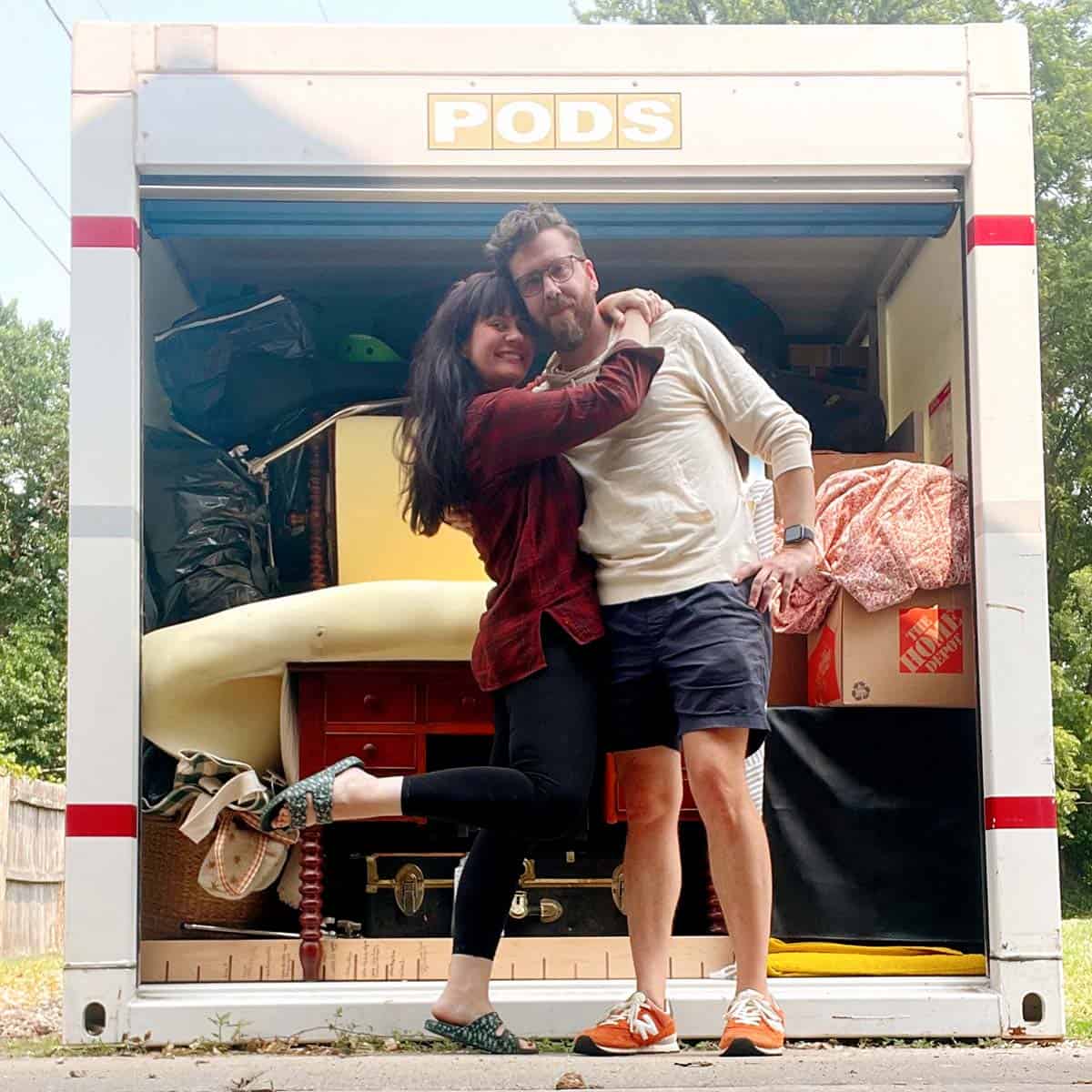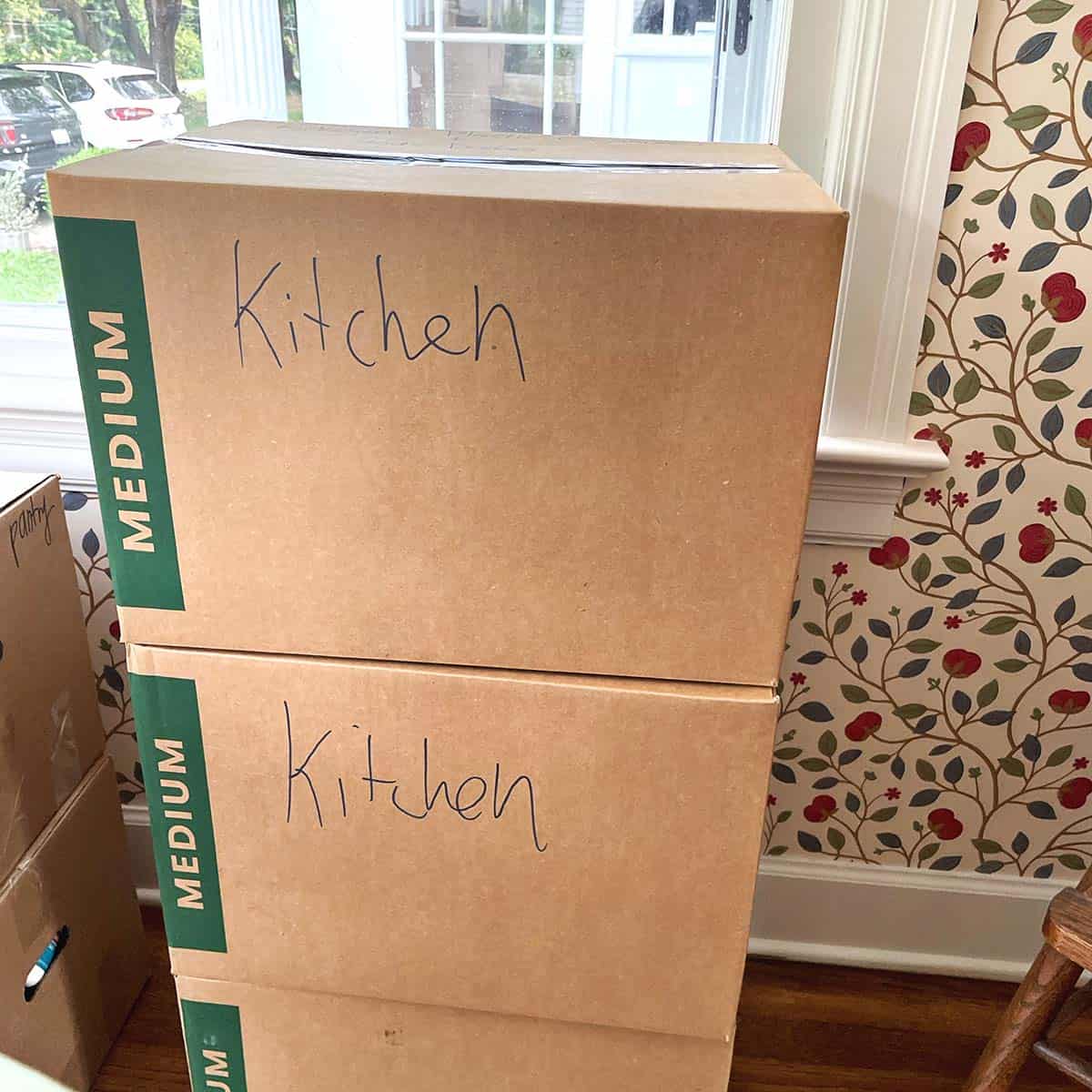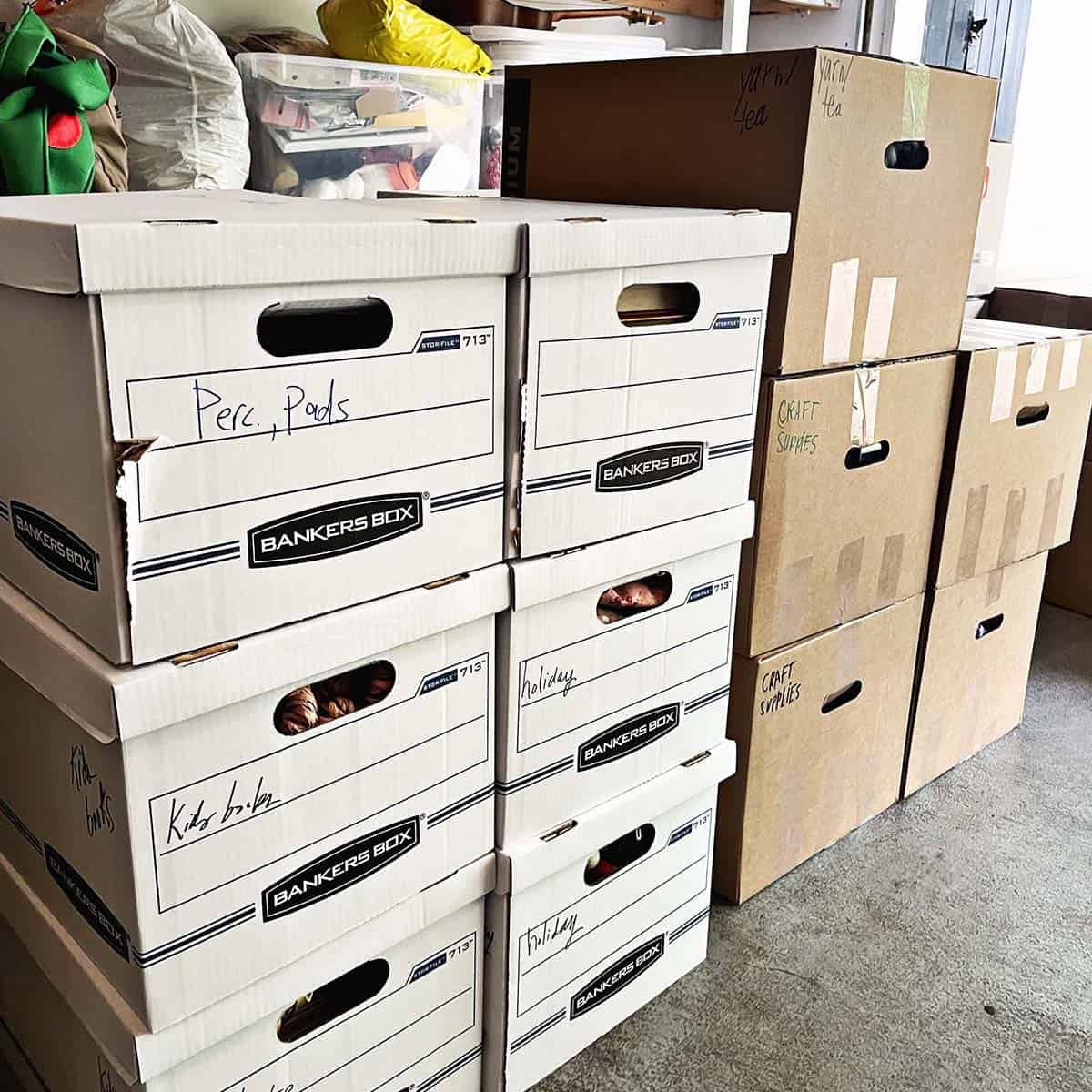
If there’s one thing I am experienced at over the past five years, it’s moving! For better or for worse, we have just completed our third move within five years (with two kids and pets!).
In this post, I will teach you everything I have learned about how to pack, how to move efficiently, and settle into your new home quickly. We’ll also cover budget tips and pointers for making the transition smooth for children.
I also have passionate feelings about the best packing supplies that streamline the process—especially if you are doing all the packing yourself!
Related: What I Learned Moving With Kids and How We Prepped Our Home To Sell.

Packing Tips For Moving
We chose to pack our own boxes because we wanted to take advantage of the chance to declutter and donate items as we packed.
I see the obvious benefits of hiring a mover to pack all your belongings for you, but I would at least consider doing it yourself if you feel you have a lot of clutter to get rid of. We spent time packing our belongings on nights and weekends.
Throughout this process, we saved thousands of dollars in moving fees and we were able to donate a lot of stuff instead of moving it and then donating it later. Here are my tips for doing your own packing:
- Get matching boxes. I completely understand how tempting it is to try to save all your Amazon boxes or procure some boxes from a local grocery store. But hear me out—it’s worth it to get boxes that are all exactly the same size. The boxes we used were primarily medium boxes with handles and bankers boxes (which require no packing tape). I highly suggest bankers boxes for books and heavy, small items.
- Use clothing bags for clothing and linens. We purchased plastic storage bags for moving all our “soft stuff” like clothing, bed linens, pillows, and even items like kids toys. These bags fit a lot more than boxes and create a plush layer that is great to use as padding in your POD for furniture, mirrors (or other items that you are very concerned about protecting).
- Label everything. Even if the box you are packing seems “random,” try to resist the urge to label it that way or not label it. Instead, make notes on the boxes of any items you may try to find later. If you want to do a color coded system, I recommend these moving box labels.
- Declutter ruthlessly as you go. As I mentioned above, one of the best perks of packing your own boxes is you can simultaneously declutter your belongings as you go. I recommend getting rid of anything that you don’t use, you don’t love, or that you’ve outgrown in style. I like to use the Marie Kondo “Does it spark joy?” method. Try to donate as much as possible.
Booking a Moving Service
After reading our friend Julia’s moving fraud experience, we decided against a moving broker or a full service moving company. I am sure there are many reputable options out there, but after reading her story we felt safest with a simple POD moving option.
Having used a POD in the past to relocate across state lines, we knew what to expect and felt good about the option.
The biggest difference between a POD and a moving truck like U-Haul is that you don’t have to drive to POD yourself. So once it is packed and locked up, you can drive to your new home (or even fly) with minimal belongings and you know your POD will make its way to you in a few weeks time.
The way our POD experience worked is that we booked an exact day that our POD would arrive—about a week before we departed from our home in Tennessee. Once the POD arrived, it sat in our driveway for around a week.
You can choose to pack the POD yourself or hire a local mover to help you pack it. We chose to do a hybrid approach. We packed the majority all our boxes ourselves over about a month’s time before the POD arrived.
On the day the POD was dropped off in our driveway, my husband loaded the majority of our boxes himself. He wanted to do this because he was meticulous about putting all the heavy boxes at the bottom. He packed each row all the way to the ceiling so there was almost no wasted space.
The next day, a moving crew arrived and helped us move large and heavy items into the POD that we couldn’t have done on our own. Since we sold most of our furniture with our home, we only had about 10 big and heavy items to move and it took less than an hour.
Once that was completed, we used every inch of the remaining space to fit more stuff into the POD. We ended up using 100% of the space within the POD and were able to fit almost everything we wanted into the space. What we couldn’t fit, we squeezed into our cars or donated before moving.
Why we like PODS – First of all, PODS are affordable. I haven’t found a more affordable option for moving across country. I really like that you have up to a week to pack so there’s time to get it just right (most of my mistakes in life are a result of rushing).
The POD system is extremely simple and straightforward. We felt protected from fraud and we saved a lot of money on the move overall. Our move cost under $4,000 total, which is a big savings on what it would have been with a full service option.
Cons of PODS (be careful for these things) – The biggest complaint that I hear from people who have used a POD for moving is that a lot of stuff was broken or damaged. You are basically packing a small semi truck back and then you don’t see it for about two weeks when it arrives in your new driveway.
What happens to them during their journey? This is unclear, but it seems like they maybe go to hell and back. Haha! OK, but really—you have to be very strategic in your packing! It’s up to you to make sure furniture is sufficiently padded and secured.
Assume that the items in your POD are going to have a VERY rough trip and pack accordingly.
There are several things we would NOT put in a POD and instead kept in our cars that we drive. One was very expensive equipment like computers, frame TVs, and my husband’s music gear.
Another thing is plants. I personally would not put plants in a POD unless you absolutely had to because they may not make it.
The last thing to be careful about is anything that can melt or freeze. Depending on the season, be careful and remember that this POD is not temperature controlled. I would not put candles and things like that in the POD as they could melt and make a mess.
The last con of moving with a POD is that you don’t know the exact day it will arrive at your new home. You will be given a window of time. So you have to be flexible and able to live without EVERYTHING in your POD for up to a week or two extra.
To make up for this, we made sure we packed two weeks of clothing in our cars and you’ll want to pack other essentials (like maybe air mattresses to sleep on) until your POD arrives.

Moving Tips and Hacks
- Pack a “comfort box” for each member of your family, including pets. Items you will find in our comfort boxes are anything you can pull out the first night to feel comfort. Examples include the kids’ favorite blankets and stuffies, my favorite candle with a lighter to light it right away, favorite snacks, socks, tea or coffee. It’s also a good idea to pack essential items in an overnight bag like toothbrushes and a few changes of clothing. Your future self will thank you!
- Keep one box for super important items like passports, bills you will need to pay (basically anything that can not get lost for a month).
- Pack boxes fully. Don’t leave big gaps in boxes. We filled in many of our boxes with towels, extra clothing, even rolls of toilet paper.
- I have moved my clothing on hangers several times. To do this, you keep bundles of clothing on hangers and cover them with (unscented) trash bags that are turned over with a hole for the hangers. It saves a lot of time.
- Choose boxes that are uniform in size and have handles. Our favorite options are this size for bigger items (kitchen appliances, toys, etc.) and this size for books and decor.
- Label necessary items you will need immediately VERY clearly. Make them very easy to find. This could include sheets and blankets, towels, toiletries and daily use kitchen items like a coffee maker or tea kettle.
- Reward yourself for all your hard work. You deserve it!
Note: If any part of you feels guilty buying moving supplies instead of procuring freebies and cast offs, here is my pep talk. Most importantly, uniform boxes and bags will make your moving truck packing more tight and professional.
And remember—you can pass ALL of these items along to the next person you know who is in need of moving supplies. Nothing needs to be wasted. Almost everything can be used again.

Get Organized Before You Move
Here are some ideas for your pre-move checklist:
- Schedule utilities, internet, lawn care, or any other services needed for your new home.
- Schedule a stop date for services at your previous home. We typically do it right after the new owners take occupancy and let them know the date so they can schedule new services.
- Have your mail forwarded to your new address by USPS. Change your address on all accounts you use often (like Amazon, any bills you receive each month, your bank, etc.).
- Schedule a grocery delivery for the day you move into your new home.
- Change the address for any subscriptions you have that arrive each month.

Best Moving Boxes and Packing Supplies
These are the supplies that I personally used. It’s very annoying to have to run to the store for simple things like more boxes or tape, so stocking up before you begin packing is smart. I reordered a few things as we began to run low.
- Medium boxes with handle holes. These are our go-to boxes for larger items. We only used a few boxes larger than this. The majority of our stuff like kitchen appliances, kids toys and things like that fit within these medium size boxes. They are the best size so they don’t get too heavy you can’t lift them.
- Bankers boxes. These are the best for packing books, files and any kind of paperwork. I LOVE these boxes because they don’t require any packing tape (at all!) and once you learn to fold them they are quick and easy to assemble. I also love how easy the tops are to take on and off. I strongly recommend these boxes for books because they are stronger than taped bottoms and don’t get too heavy. We moved hundreds of books in these boxes with no issues.
- Clothing bags. These are great for clothing and also linens, pillows, and holiday decor like Christmas trees, garlands, and wreaths.
- Moving labels. These are great because they are color coded as well!
- Safer box cutter. I love this thing! It’s easy to use, works great and is far safer than a metal razor blade.
Tips For Moving Cross Country
Strategy is everything when moving across state lines with children and pets. Since the majority of our belongings were in our POD on moving day, we stuffed our vehicles with everything else we could fit.
Unfortunately, we ran out of space and had to give some items away at the last minute. This is common, so plan for it by packing your top priority items first.
On our moving day, I had the car with our dog and two kids, and my husband drove our other car, which was way more stuffed with belongings.
- Plan carefully. Since space (both in your new home and your moving vehicle) will probably be limited, plan as well as possible and try not to pack things you will need to sell or donate once you arrive. Also, be strategic in what you pack, prioritizing as you go and leaving optional items for last. If you are packing in a rush, it’s hard to purge as you go, so I recommend starting as far in advance as you can. Ideally with months or weeks to pack.
- Sell, donate, purge. Before moving, get rid of everything you aren’t sure will work in your new home. If your new space is a different era or style or if your preferences have changed, consider this an opportunity to start fresh. I downsized my closet by about 50% before moving and we ended up selling our house with most of the furniture included. Even still, I donated about five more kitchen boxes immediately the first week we were in our new home. Purging as you go will help to eliminate some of this wasted effort and make unpacking more of a pleasant experience.
- Ship helpful items to yourself. Because we used the POD system, I knew we wouldn’t have beds or mattresses. So, I shipped us some nice air mattresses to use the first week, along with some other useful items like cleaning sprays and toilet paper—all the stuff you need immediately.
- Create comforts anytime you can. When we pulled into the driveway of our new home, my in-laws were in the front yard waiting for us. My mother-in-law had offered to buy us groceries that day (I should have said yes!). We had a scheduled deep clean a few days before we moved in. We did the comfort box idea and I had candles to burn and our kids’ favorite blankets and pillows. Even with all of these comforts, the moving day is stressful and exhausting. My suggestion is to do as many of these comforting tips as you can, but also accept that no matter how hard you try, moving is an emotional experience with highs and lows. This is to be expected and normal.
Tips for Moving with Children and Pets
I’ve moved several times with our young children and we get a lot of questions about how to make it easier on kids. The truth is that leaving your school, the comforts of the home, neighborhood and town your child knows is very scary.
For our children, the big feelings seemed to come in waves and the worst of it was weeks after we moved when the dust began to settle.
In addition to the comfort boxes, which we talked about above, I have a few tips for navigating a move with children.
- Leave space for sad feelings. There is nothing wrong with missing your old home, school, friends, or life before a move. Leave space for these feelings and for your child to work through them at whatever speed they need to. Sad feelings about a previous home or school are not a reflection on how they feel about the new home or new school. You can feel two feelings at the same time—these are normal, healthy emotions.
- Create things to look forward to. When we first told our children that we sold our home furnished and that we were leaving all the furniture (even their beds), they reacted with sadness, which we expected. To help the kids feel excited for our move, we let them help us choose new beds for each of their rooms along with themes and colors for their walls. We also reminded them often of the reason we were moving—so they could see their family whenever they wanted. This was a huge help and comfort to us as the move approached.
- Do fun activities right away. The week we moved, my husband and I were overwhelmed and exhausted. If it were just the two of us, we probably would have ordered in every night and never left the house. With the kids, we found it useful to jump into new activities right away. We joined a pool where they could go swimming with their baby cousin, we walked to dinner in our neighborhood, and I took each child out for individual time like visiting the local bookstore and going out for ice cream. These extra activities brought the kids a lot of comfort and joy and gave us a soft place to land that first week.
Moving with pets. Our dogs have tended to be pretty flexible in all our moves. My suggestion is to give them a few extra treats, extra walks, and a consistent place to sleep from the first night. I have heard that moving with cats is more of a challenge, so if you have had that experience I’d love to hear your learnings in the comments.
If you have any tips for moving, packing or navigating change, I’d love to hear them in the comments! Love, Elsie